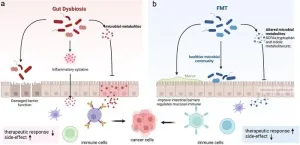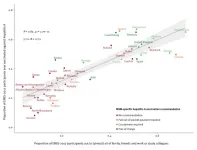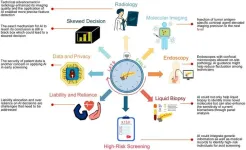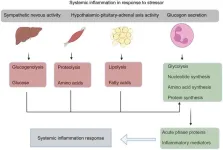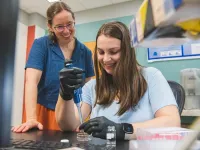(Press-News.org) Before 2024 ends, Congress will decide whether to keep or change rules about telehealth, or let them expire. And even though the decision will focus on Medicare’s payment for virtual patient care, it will likely impact telehealth access for people with other kinds of health insurance too.
Now, a new University of Michigan study suggests that policymakers can rest easier about one of the top worries about telehealth: that virtual care will drive up the use of tests and scans that patients don’t need, wasting money and resources.
In fact, the study shows that low-value care didn’t rise faster at primary care practices that used telehealth the most, compared with those that used it the least.
And in some cases, the high-telehealth-use practices saw a faster drop in low-value care.
The study, published in JAMA Network Open, focuses on eight low-value tests, scans and procedures that experts agree aren’t needed in certain groups of patients. This included blood tests to screen for prostate cancer risk in men over age 75, CT scans for people with uncomplicated sinus infections or back pain, Pap smears to look for early signs of cervical cancer in women over age 65, and colon cancer screening in people over age 85.
While some have worried that such low-value care might rise when physicians and other providers see more patients virtually and can’t conduct physical exams, the study showed this did not happen.
“Our findings are reassuring in the context of current telehealth policy decisions, because there has been concern that telehealth might be increasing access to care to a degree that leads to unnecessary visits and wasteful screening or diagnostic testing ,’ said lead author Terrence Liu, M.D., M.S., a primary care physician in the Division of General Medicine at U-M Health and National Clinician Scholar at the U-M Institute for Healthcare Policy and Innovation.
He and his colleagues used data from nearly 578,000 Michiganders covered by traditional Medicare, who saw providers in more than 2,550 primary care clinics between 2019 and 2022. The researchers divided those clinics into three groups of high, medium and low telehealth use based on how frequently they billed Medicare for virtual care visits by video, phone and other virtual care services in 2022. They also accounted for differences in the number of patients each clinic saw.
In addition to failing to show a rise in low-value care at high-telehealth practices, the study also confirms an earlier U-M finding using data from 2021. That study addressed another fear about virtual care: that the rate of in-person visits would increase because of a need for follow-up appointments to address something identified in virtual visits. In both that study and the new one using data from 2022, the rate of in-person visits decreased in the telehealth era.
Liu and colleagues zeroed in on the eight low-value care types because they’ve been studied by others and have been targeted for reduction by major medical professional societies.
In six of the eight types of care, the rate of patients receiving them dropped or stayed about the same between 2019 and 2022, no matter how much telehealth a clinic provided.
But in two cases – cervical cancer screening for women over 65, and ongoing blood monitoring for a thyroid hormone in people with hypothyroidism – the medium- and high-telehealth clinics showed an even faster drop than the low telehealth clinics.
The new study focuses on types of low-value care that occurs most commonly in the primary care setting, using well-established methods for identifying low-value care in Medicare records. It took into account the trend in recent years for an increasing percentage of older adults to choose Medicare Advantage rather than traditional Medicare.
While the new study focuses on data from Michigan that the team obtained from the Michigan Value Collaborative, Liu and colleagues now plan to repeat the analysis using a sample of national Medicare data.
Liu worked on the study with senior author Chad Ellimoottil, M.D., M.S., who directs virtual care for the U-M Medical School’s faculty group practice, called the Michigan Medical Group. A. Mark Fendrick, M.D., the director of the U-M Center for Value Based Insurance Design, is a co-author.
“I view telehealth as a way to supplement providers’ usual ways of delivering care, and wouldn’t expect it to necessarily improve health care quality or decrease cost by reducing low-value care on its own,” said Liu. “We need to find ways to best integrate telehealth into our current healthcare delivery system and think of how to reduce low-value care in both the in-person and virtual setting.”
“These important findings suggest that regardless of whether initial care recommendations are made in person or virtually, factors such as access to care, out of pocket costs and the time and effort required by patients to complete both high and low-value medical services play an important role in their use,” said Fendrick.
Liu, Ellimoottil, Fendrick and co-authors Michael Thompson, Ph.D., Chiang-Hua Chang, Ph.D., and Jeffrey McCullough, Ph.D. are all members of the U-M Institute for Healthcare Policy and Innovation.
Citation: Primary care practice telehealth use and low-value care services, JAMA Network Open, DOI:10.1001/jamanetworkopen.2024.45436
END
Does more virtual care mean more low-value care? Study suggests no
Analysis of 2022 data from Michigan Medicare participants shows that despite worries, use of unneeded scans & tests didn’t rise at primary care practices that embraced virtual care the most
2024-11-07
ELSE PRESS RELEASES FROM THIS DATE:
City of Hope Research Spotlight, October 2024
2024-11-07
City of Hope® Research Spotlight offers a glimpse at groundbreaking scientific and clinical discoveries advancing lifesaving cures for patients with cancer, diabetes and other chronic, life-threatening diseases. Each spotlight features research-related news such as recognitions, collaborations and the latest research defining the future of medical treatment.
This roundup highlights the biology behind our sense of smell, real-world data that can be used to refine esophageal cancer treatment guidelines, a potential new approach to treating patients with type 2 diabetes, a new way to target pancreatic cancer ...
Increased focus on comorbidities, socioeconomic factors would help improve health equity for people with COPD
2024-11-07
Miami (November 7, 2024) – Health care providers treating people with COPD also need to focus on the person’s socioeconomic factors, along with considering their additional health conditions or comorbidities, according to a new article. The article is published in the September 2024 issue of Chronic Obstructive Pulmonary Diseases: Journal of the COPD Foundation, a peer-reviewed, open-access journal.
Chronic obstructive pulmonary disease (COPD) is an inflammatory lung disease, comprising several conditions, including chronic bronchitis and emphysema, and can be caused by genetics ...
Gut dysbiosis and fecal microbiota transplantation in pancreatic cancer: Current status and perspectives
2024-11-07
Pancreatic ductal adenocarcinoma (PDAC) is recognized as one of the most lethal cancers, with an estimated five-year survival rate of approximately 10%. This poor prognosis is largely attributed to the challenges in early diagnosis, aggressive tumor biology, and limited treatment options. Most PDAC cases are diagnosed at advanced stages due to its typically asymptomatic onset, making only a small percentage of patients eligible for potentially curative surgical resection. In recent years, increasing attention has been paid to the role of gut microbiota dysbiosis in PDAC, as ...
Prevalence of unrecognized cognitive impairment in socially and economically vulnerable older adults is high
2024-11-07
INDIANAPOLIS – One of the first studies to investigate the prevalence of unrecognized cognitive impairment among patients seen at Federally Qualified Health Centers, has found that it is ubiquitous, especially among minoritized older adults. These facilities provide primary care and preventive services regardless of ability to pay or health insurance status to more than 30 million patients, including a growing number of older adults.
Early and equitable detection of cognitive impairment can benefit patients and their families. Delaying diagnosis leads to poor health outcomes for patients ...
Men who have sex with men in Europe still vulnerable to hepatitis A and B, highlighting need for public health action and support
2024-11-07
Research analysing European survey data from 113,884 men who have sex with men (MSM) and published in Eurosurveillance indicates that while most MSM have a basic understanding of viral hepatitis, only 44% report having been vaccinated against both hepatitis A and B. The data highlight notable immunisation gaps despite available vaccination and recommendations. Strong public health support and creating an open environment that enables MSM to follow recommendations will be crucial to reduce outbreaks among MSM and eliminate hepatitis B.
Men who have sex with men are more likely to get infected with ...
Cancer genetic risk assessment guidelines expand to meet growing understanding of hereditary risk
2024-11-07
PLYMOUTH MEETING, PA [November 7, 2024] — The National Comprehensive Cancer Network® (NCCN®)—an alliance of leading cancer centers focusing on maintaining evidence-based expert consensus driven guidelines for care—announces the publication of the expanded NCCN Clinical Practice Guidelines in Oncology (NCCN Guidelines®) for Genetic/Familial High-Risk Assessment: Breast, Ovarian, Pancreatic, and Prostate. This closely follows the recent publication of the expanded NCCN Guidelines® for Genetic/Familial High-Risk Assessment: Colorectal, Endometrial, and Gastric.
Additional cancer types were added to the title and content for both guidelines. ...
Advances in screening and early diagnosis of pancreatic cancer
2024-11-07
Pancreatic cancer (PC) presents substantial diagnostic challenges due to its aggressive nature and lack of early symptoms, leading to late detection and poor prognosis. According to recent cancer statistics, PC ranks as the fourth leading cause of cancer deaths globally, with increasing incidence, particularly in high-risk regions such as China. Factors such as a shortage of specific and reliable screening markers, along with a lower prevalence in the general population, make effective large-scale screening a formidable tasko assess advancements in diagnostic techniques, artificial intelligence integration, biomarker discoveries, ...
Metabolic dysregulation and metabolite imbalances in acute-on-chronic liver failure: Impact on immune status
2024-11-07
Acute-on-chronic liver failure (ACLF) is a life-threatening condition characterized by acute deterioration of liver function in patients with pre-existing chronic liver disease. It is often accompanied by multiorgan failure and systemic inflammation, with high short-term mortality rates. The triggers for ACLF include bacterial infections, acute alcoholic hepatitis, and ischemic hepatitis, leading to the release of pro-inflammatory mediators. These systemic inflammatory responses result in immune dysfunction, contributing to the progression of the disease.
Recent research has emphasized the metabolic changes ...
Elite coaches see compassion as a path to better performance
2024-11-07
It may sound like a contradiction to talk about compassion in the competitive world of elite sport. After all, isn't elite sport all about becoming hardened to resistance and adversity?
But this is a false dichotomy, according to a new study that analysed the views of 12 Danish high-performance coaches on the use of compassion in their work with elite athletes.
In fact, there is a broad consensus among the coaches, most of whom are head of national teams, about the benefits of using compassion, says the study's lead author, Emilia Backman from the Department of Psychology, University of Copenhagen.
"All of the high-performance ...
Microplastics impact cloud formation, likely affecting weather and climate
2024-11-07
UNIVERSITY PARK, Pa. — Scientists have spotted microplastics, tiny pieces of plastic smaller than 5 millimeters, in some of the most pristine environments on Earth, from the depths of the Mariana Trench to the snow on Mt. Everest to the mountaintop clouds of China and Japan. Microplastics have been detected in human brains, the bellies of sea turtles and the roots of plants. Now, new research led by Penn State scientists reveals that microplastics in the atmosphere could be affecting weather and climate.
The study, published today (Nov 7) in the journal Environmental Science and Technology: ...
LAST 30 PRESS RELEASES:
Artificial saliva containing sugarcane protein helps protect the teeth of patients with head and neck cancer
Understanding the role of linear ubiquitination in T-tubule biogenesis
Researchers identify urban atmosphere as primary reservoir of microplastics
World’s oldest arrow poison – 60,000-year-old traces reveal early advanced hunting techniques
Bristol scientists discover early sponges were soft
New study uncovers how rice viruses manipulate plant defenses to protect insect vectors
NSF–DOE Vera C. Rubin Observatory spots record-breaking asteroid in pre-survey observations
Ribosomal engineering creates “super-probiotic” bacteria
This self-powered eye tracker harnesses energy from blinking and is as comfortable as everyday glasses
Adverse prenatal exposures linked to higher rates of mental health issues, brain changes in adolescents
Restoring mitochondria shows promise for treating chronic nerve pain
Nature study identifies a molecular switch that controls transitions between single-celled and multicellular forms
USU chemists' CRISPR discovery could lead to single diagnostic test for COVID, flu, RSV
Early hominins from Morocco reveal an African lineage near the root of Homo sapiens
Small chimps, big risks: What chimps show us about our own behavior
We finally know how the most common types of planets are created
Thirty-year risk of cardiovascular disease among healthy women according to clinical thresholds of lipoprotein(a)
Yoga for opioid withdrawal and autonomic regulation
Gene therapy ‘switch’ may offer non-addictive pain relief
Study shows your genes determine how fast your DNA mutates with age
Common brain parasite can infect your immune cells. Here's why that's probably OK
International experts connect infections and aging through cellular senescence
An AI–DFT integrated framework accelerates materials discovery and design
Twist to reshape, shift to transform: Bilayer structure enables multifunctional imaging
CUNY Graduate Center and its academic partners awarded more than $1M by Google.org to advance statewide AI education through the Empire AI consortium
Mount Sinai Health system receives $8.5 million NIH grant renewal to advance research on long-term outcomes in children with congenital heart disease
Researchers develop treatment for advanced prostate cancer that could eliminate severe side effects
Keck Medicine of USC names Christian Pass chief financial officer
Inflatable fabric robotic arm picks apples
MD Anderson and SOPHiA GENETICS announce strategic collaboration to accelerate AI-driven precision oncology
[Press-News.org] Does more virtual care mean more low-value care? Study suggests noAnalysis of 2022 data from Michigan Medicare participants shows that despite worries, use of unneeded scans & tests didn’t rise at primary care practices that embraced virtual care the most




